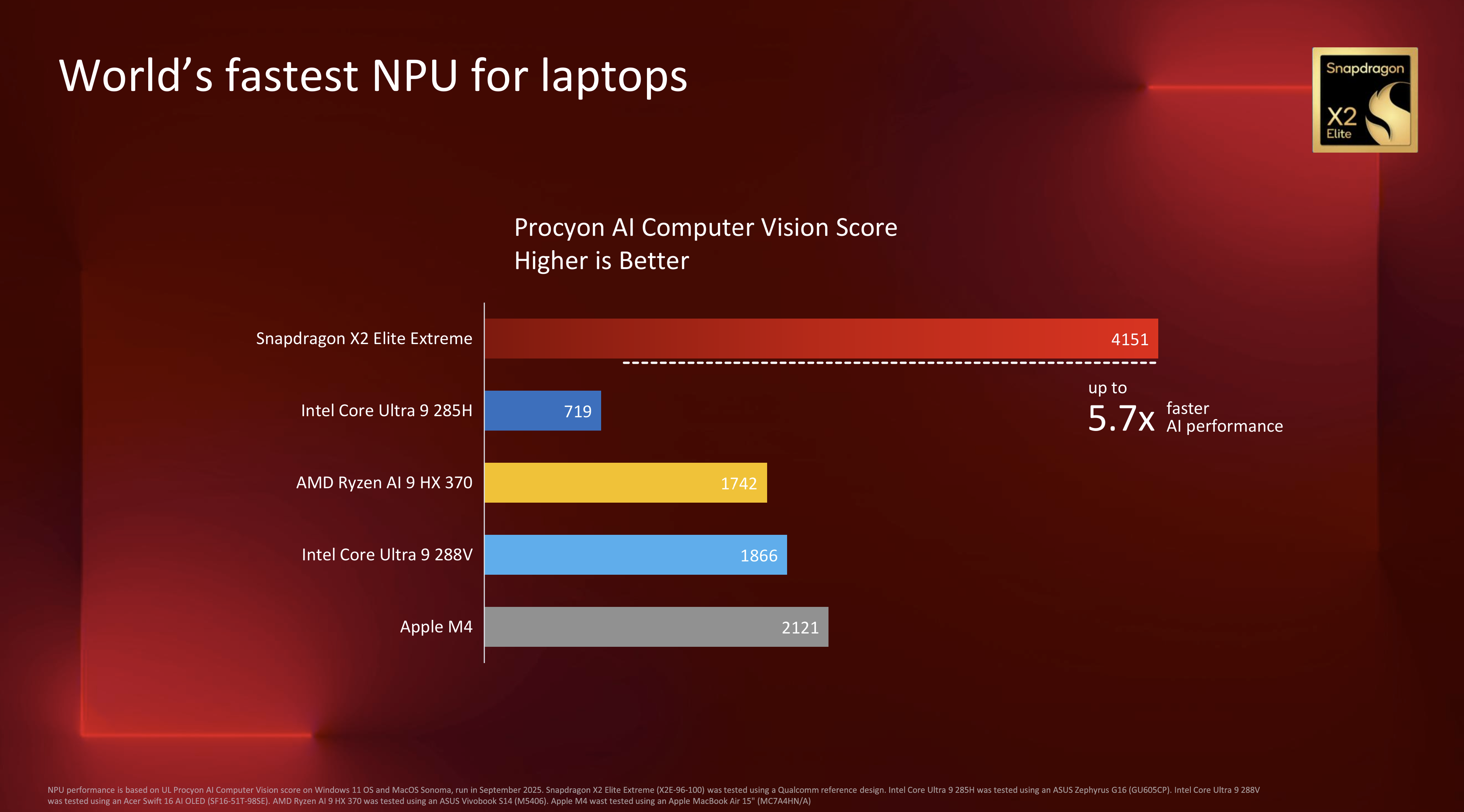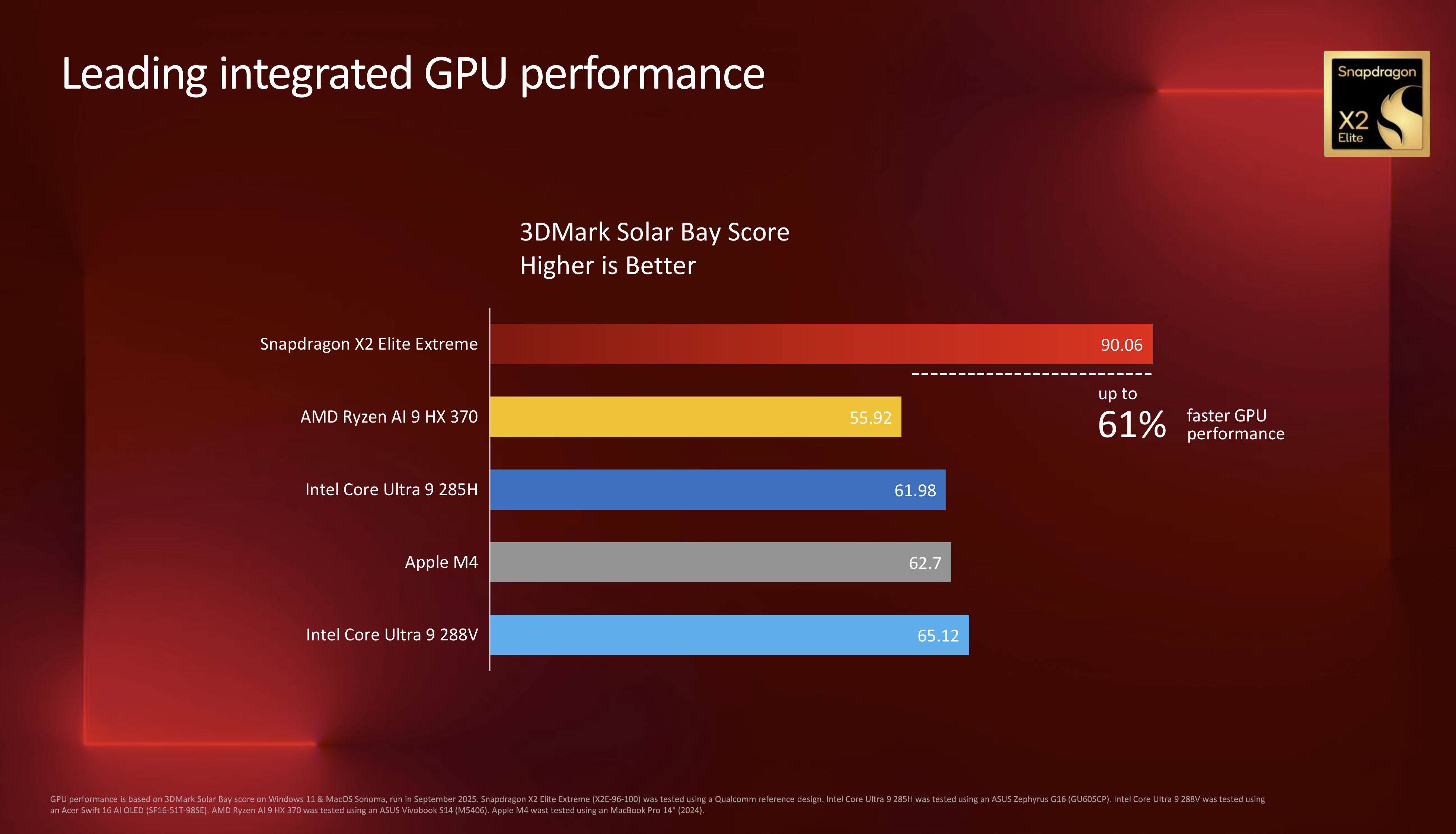Snapdragon X2 Elite Extreme vs. Apple M5 | ARM-based computing levels up, but how do these chips compare?
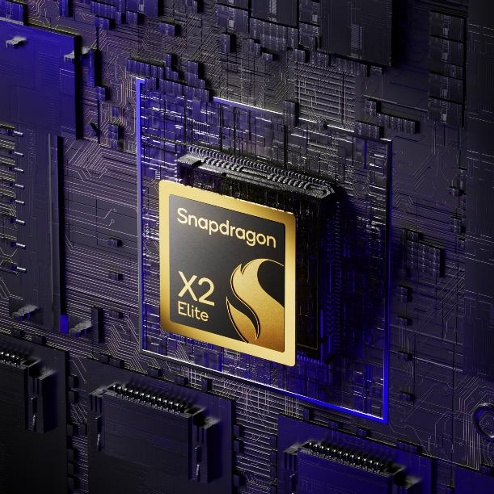
Qualcomm's Snapdragon X2 Elite and X2 Elite Extreme Systems-on-Chip (SoC) are expected to launch early next year in Windows laptops, and they'll have some strong competition against Apple's new M5 silicon.

Apple's next-gen silicon so far only includes the standard M5 — no Max or Pro chips yet — and it's arriving in the MacBook Pro 14 on October 22. Early performance numbers suggest it will compete well against the Snapdragon X2 series.
Apple revealed its new M5 silicon for MacBook Pro, iPad Pro, and Apple Vision Pro on October 15, 2025, roughly three weeks after Qualcomm unveiled its new Snapdragon X2 Elite and X2 Elite Extreme ARM-based chips for Windows PCs.
I'm not expecting to see any of Qualcomm's next-gen X2 Elite and Extreme chips arrive in PCs until early next year, and Apple is remaining tight-lipped regarding any performance benchmarks before the M5 officially arrives in the MacBook Pro 14 October 22.
Regardless, I've put together an early comparison of the Apple and Qualcomm chips, including some early leaked benchmark numbers.
Snapdragon X2 Elite vs. Apple M5: CPU performance
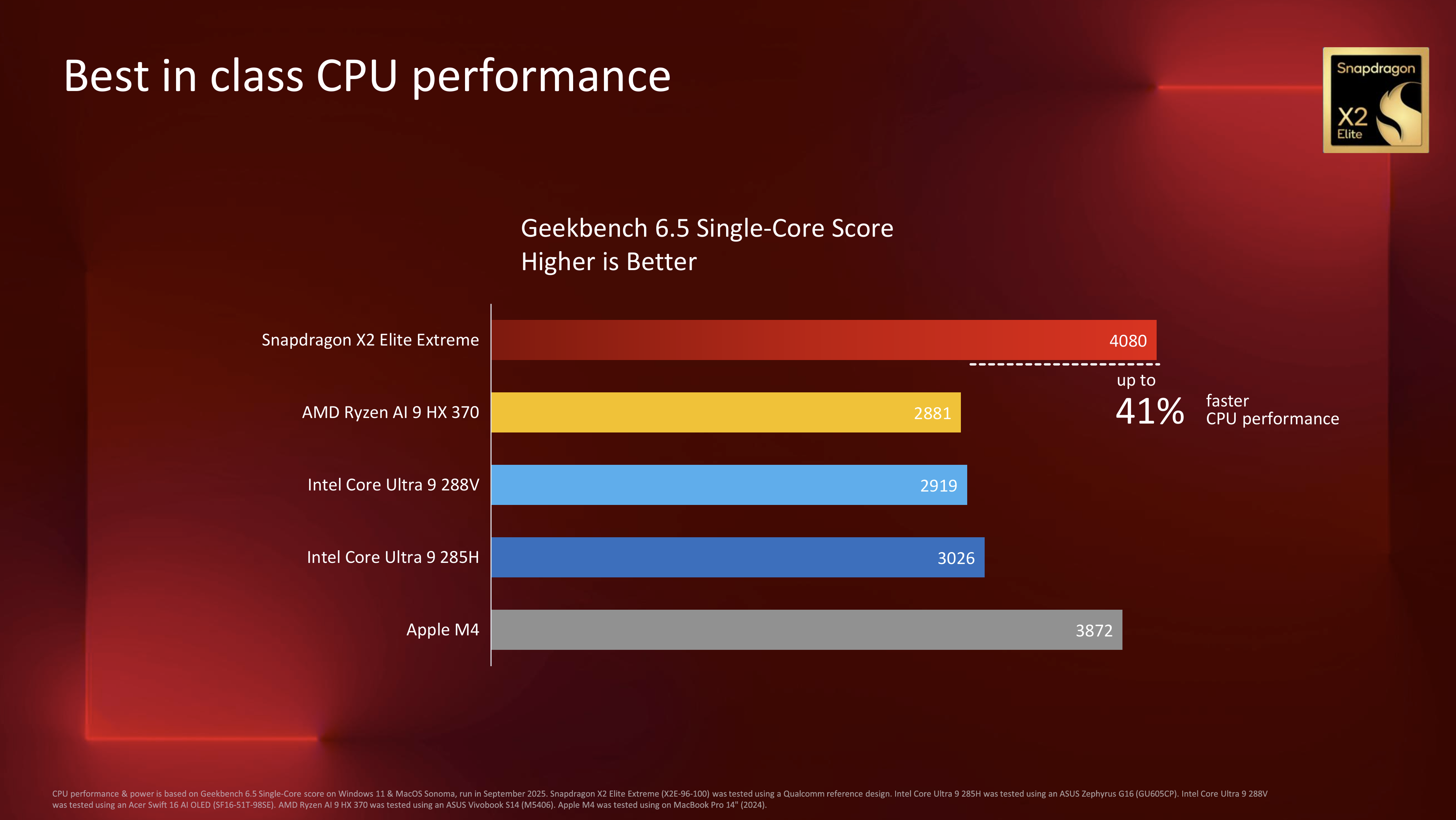
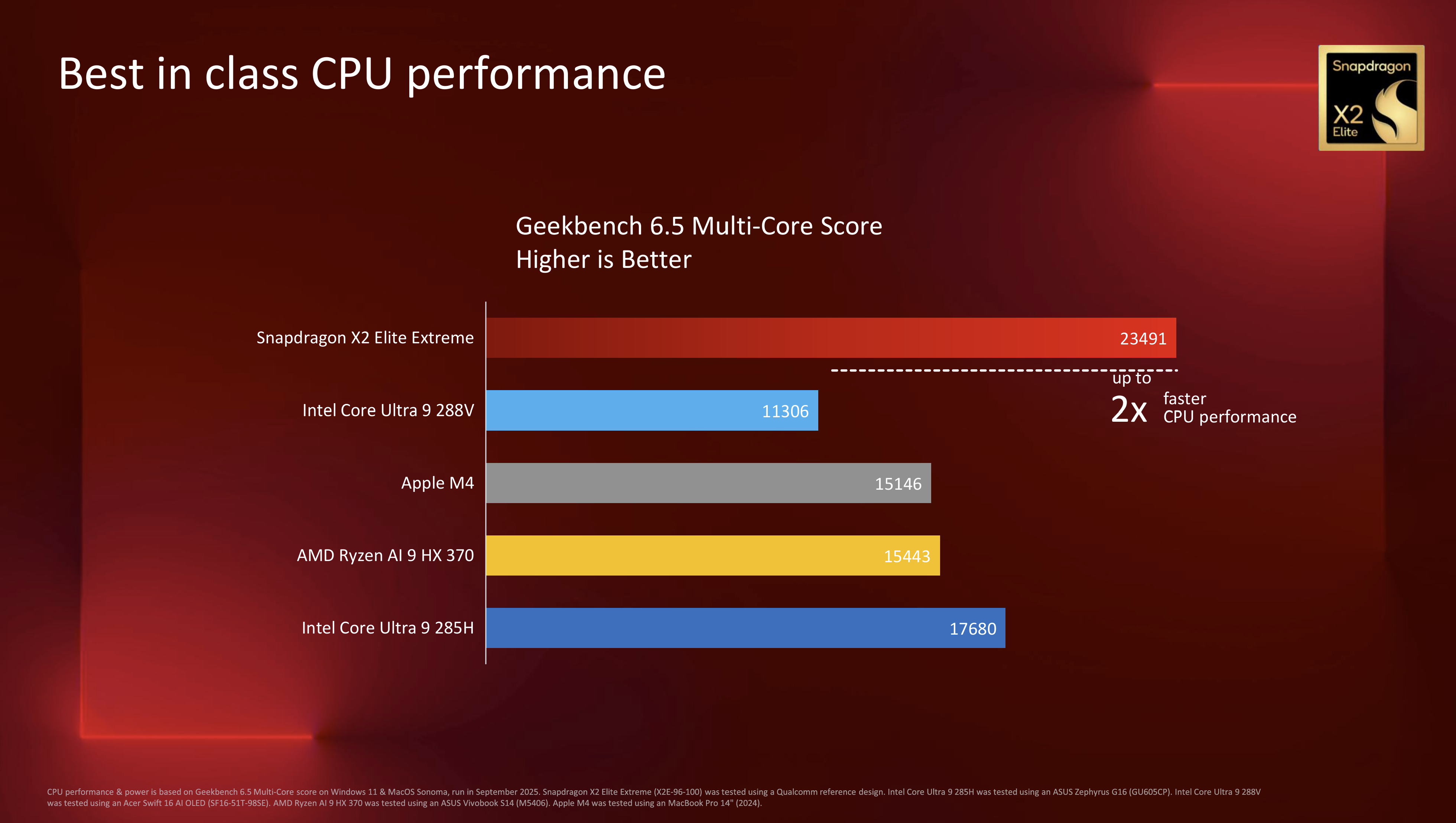
Qualcomm's Snapdragon X2 Elite platform is divided into three parts. There's the flagship X2 Elite Extreme (X2E-96-100) System-on-Chip with 18 cores, clock speed up to 5GHz, GPU clock up to 1.85GHz, and 228GB/s memory bandwidth.
One step down is the X2 Elite (X2E-88-100) with the same 18 cores but a lower 4.7GHz clock speed and 1.7GHz GPU clock. Then there's the X2 Elite (X2E-80-100) with 12 cores, 4.7GHz clock speed, and 1.7GHz GPU clock. Both of the X2 Elite chips offer up to 152GB/s memory bandwidth.
The new Apple M5 is home to just one chip for now; if Pro and Max versions are on the way, Apple still hasn't made anything official. Like the X2 Elite chips, Apple's M5 is built using 3nm technology.
👉 Related: Snapdragon X2 Elite Extreme vs. Apple M4
All the latest news, reviews, and guides for Windows and Xbox diehards.
Apple lays claim to "the world's fastest performance core" in the M5, and there are up to four of them in the 10-core CPU option (the other six cores are of the efficiency type). Compared to the M4, Apple says this combination delivers up to 15% faster multithreaded performance.
The M5's memory bandwidth hits 153GB/s, which is 1GB/s faster than the X2 Elite chips and 75GB/s slower than the X2 Elite Extreme.
Geekbench | Single-core | Multi-core |
|---|---|---|
Snapdragon X2 Elite Extreme | 4,080 | 23,491 |
Apple M5 | 4,253 | 17,862 |
A recent Geekbench leak (via Tom's Hardware) shows the M5 in a MacBook Pro ahead of the X2 Elite Extreme chip for single-core workloads. The M5 hit 4,253 in the leaked single-core result, higher than the 4,080 score that Qualcomm provided.
However, the X2 Elite Extreme comes out ahead in multi-core testing, hitting a score of 23,491 compared to the M5's 17,862. The performance difference there is mainly based on the X2 Elite Extreme's extra 8 CPU cores, so this result is a lot closer than I imagine Qualcomm would like it to be.
Qualcomm has mainly provided X2 Elite Extreme performance numbers at this point, which makes it hard to compare the non-Extreme versions of the chip. However, it's safe to assume that the M5 will maintain its single-core supremacy while inching closer to overtaking multi-core performance.
Snapdragon X2 Elite vs. Apple M5: AI performance
Qualcomm's Snapdragon X Elite chips kicked off the Copilot+ PC era thanks to the inclusion of a Neural Processing Unit (NPU) with enough power to run local AI tasks smoothly.
With the new X2 Elite and Elite Extreme chips, the NPU has improved greatly, hitting 80 TOPS compared to 45 TOPS in the older hardware. That bump essentially prepares the chip for the future of local AI tasks, inside and outside of Copilot+.
Qualcomm shows off a Procyon AI Computer Vision score of 4,151 for the X2 Elite Extreme, besting Apple M4's score of 2,121.
But Apple has also improved its 16-core Neural Engine for the M5. It's optimized for Apple Intelligence tools, and it complements the Neural Accelerators in the CPU and GPU.
Apple hasn't yet provided numbers I can use for comparisons, so this section will have to wait for post-launch benchmarks. However, I do know that the M4 boasted 38 TOPS of power for AI, so the M5 should surpass that.
Snapdragon X2 Elite vs. Apple M5: GPU performance
Qualcomm has buffed its integrated Adreno GPU for the X2 Elite chips, significantly boosting the frequency and, in turn, performance.
For the X2 Elite Extreme, Qualcomm used 3DMark's Solar Bay benchmark — which tests performance in ray-traced games — to test. The chip hit a score of 90.06. To compare, Apple's last-gen M4 scored 62.7 in the same test.
Within the Windows world, the X2 Elite Extreme's new GPU, combined with increased ARM compatibility in popular anti-cheat systems, has the potential to make gaming a whole lot easier on the next generation of Snapdragon laptops.
According to Apple, the M5 represents "the next big leap in AI performance" for its custom silicon. Thanks to a redesigned 10-core GPU architecture and a Neural Accelerator within each core, it's touted as being capable of delivering more than four times the peak GPU compute power than the M4.
Buffed M5 shader cores are also expected to boost graphics performance by about 30% compared to the M4, and a new ray tracing engine should boost performance by up to 45%. That puts it roughly in line with the X2 Elite Extreme's early benchmark numbers.
External display support continues to favor Qualcomm. The M5 in the MacBook Pro can support up to dual 6K@60Hz displays, each running on Thunderbolt 5. It can also run one 6K@60Hz display and one 4K@144Hz display at the same time using Thunderbolt and HDMI. For one display, the ceiling is 4K@240Hz or 8K@60Hz.
The X2 Elite series can run up to three 4K displays each at 144Hz, or three 5K displays each at 60Hz.
Snapdragon X2 Elite vs. Apple M5: More to come
I plan to revisit this comparison once more information becomes available, but for now, it's looking like the flagship X2 Elite Extreme has some serious competition from Apple's baseline M5 chip.
It will be interesting to see how Apple's M5 Pro and Max versions, if they do arrive, compare as well to these chips, and I'm also looking forward to the potential of Qualcomm releasing something more powerful than the X2 Elite Extreme.

Follow Windows Central on Google News to keep our latest news, insights, and features at the top of your feeds!

Cale Hunt brings to Windows Central more than nine years of experience writing about laptops, PCs, accessories, games, and beyond. If it runs Windows or in some way complements the hardware, there’s a good chance he knows about it, has written about it, or is already busy testing it.
You must confirm your public display name before commenting
Please logout and then login again, you will then be prompted to enter your display name.
